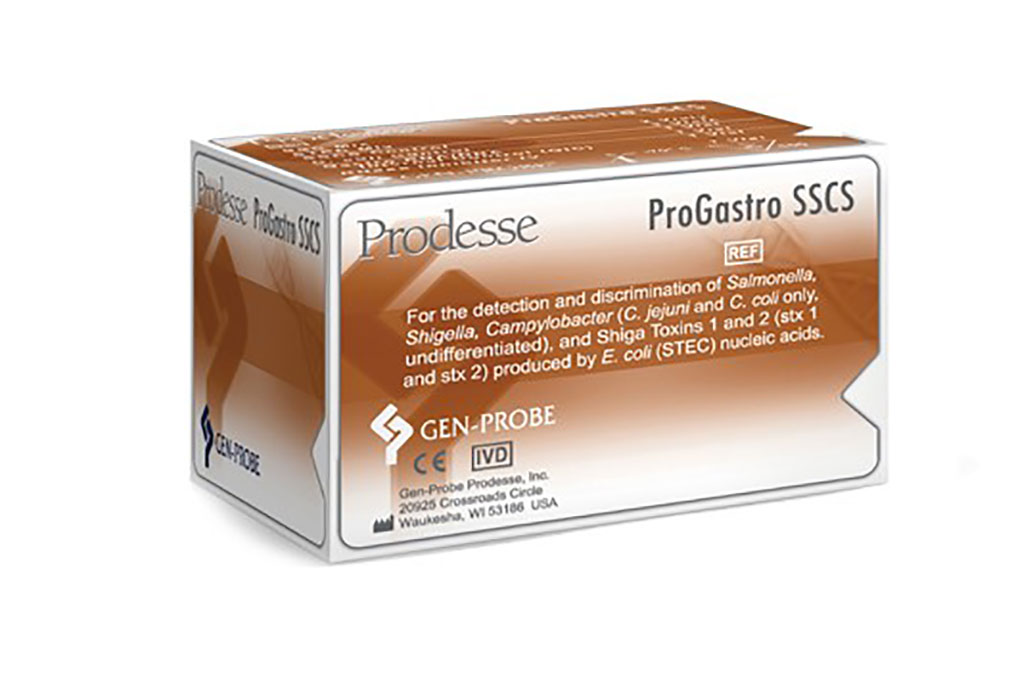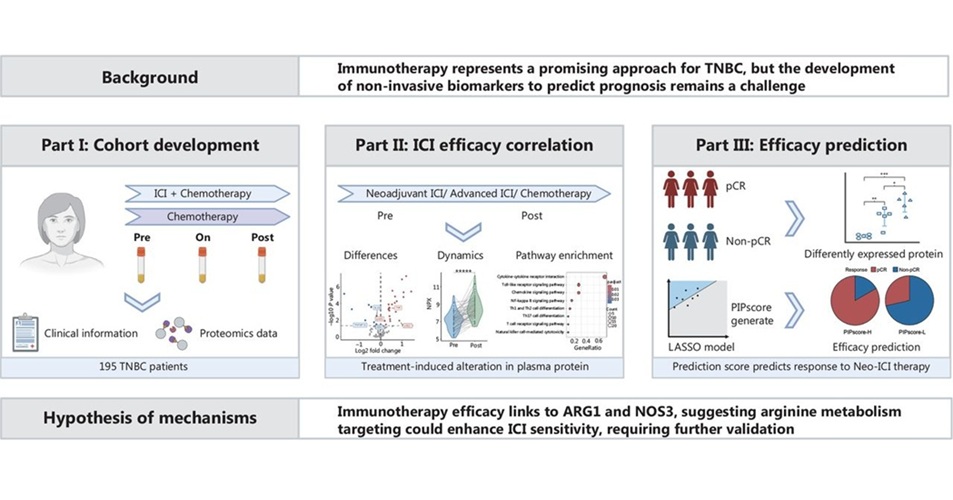Commercial RT-PCR Tests Compared to Culture for Bacterial Gastroenteritis
|
By LabMedica International staff writers Posted on 11 Jan 2022 |

Image: ProGastro SSCS is a multiplex real time PCR for the detection and differentiation of Salmonella, Shigella, Campylobacter, (C. jejuni and C. coli only, undifferentiated) nucleic acids and Shiga Toxin 1 (stx1) and Shiga Toxin 2 (stx2) genes (Photo courtesy of Hologic)
Nucleic acid-based testing (culture-independent diagnostic testing, CIDT) for bacterial gastroenteritis offers three major advantages over culture-based diagnosis: it has better analytical sensitivity, is less labor intensive through automation, and has faster turnaround times.
Multiple commercial nucleic acid test assays (i.e. real-time PCR, RT-PCR) are available, testing at a minimum of four pathogens (Salmonella, Campylobacter, Shiga toxin-producing Escherichia coli (STEC), and Shigella). However, there are many caveats associated with CIDT for bacterial gastroenteritis, and gaps in the evaluation of commercial assays.
Clinical Microbiologists at the University of Calgary (Calgary, AB, Canada) and their colleagues used clinical stool specimens and contrived samples comprising commonly circulating species, serotypes, biovars, and/or toxin subtypes were for a comparison of four commercial RT-PCR tests. The four tests were: RIDAGENE Bacterial Stool Panel and EHEC/EPEC Panel (R-Biopharm AG, Darmstadt, Germany); FTD Bacterial Gastroenteritis assay (Fast Track Diagnostics, Luxembourg); BD MAX Enteric Bacterial Panel and Extended Enteric Bacterial Panel (BD Canada, Mississauga, ON, Canada); Prodesse ProGastr SSCS Assay (Hologic Inc., San Diego, CA, USA).
The four commercial RT-PCR assays were challenged with 67 contrived stool specimens, each spiked with an isolate representing different Campylobacter species, Salmonella serotypes, Shigella species and serotypes, STEC toxin subtypes, Y. enterocolitica serotypes/biotypes, and Yersina spp; these isolates are the common circulating types in Alberta, Canada. All assays gave positive results for C. jejuni, C. coli, Y. enterocolitica, and all species and serotypes of Shigella, but negative results for Y. non-enterocoltica spp. and C. upsaliensis. Most Shiga toxin subtypes were detected by all assays except for stx2f, which was detected by Ridagene.
The performance of the four commercial assays was assessed using 171 clinical fecal specimens collected prospectively, which were initially tested by culture at the frontline diagnostic laboratories. This included feces that were 125 culture-positive or 46 culture-negative for Campylobacter, Salmonella, Shigella, STEC, or Y. enterocolitica. Using culture as a reference standard, the sensitivity for all organisms (excluding Yersinia) was >96% for all four assays and specificity was >90%, except for BD Max (87%).
The authors concluded that their study provided a third-party evaluation of four commercially available RT-PCR assays for bacterial gastroenteritis and demonstrated the assays to be mostly equivalent to each other and culture with a few caveats. Depending on the prevalence of certain stx sub-types, Yersinia species, and Campylobacter species in a laboratory's jurisdiction, without further improvement in culture-independent tests, culture methods remain critical for the detection of these pathogens. The study was published on January 1, 2022 in the International Journal of Infectious Diseases.
Related Links:
University of Calgary
R-Biopharm
Fast Track Diagnostics
BD Canada
Hologic
Multiple commercial nucleic acid test assays (i.e. real-time PCR, RT-PCR) are available, testing at a minimum of four pathogens (Salmonella, Campylobacter, Shiga toxin-producing Escherichia coli (STEC), and Shigella). However, there are many caveats associated with CIDT for bacterial gastroenteritis, and gaps in the evaluation of commercial assays.
Clinical Microbiologists at the University of Calgary (Calgary, AB, Canada) and their colleagues used clinical stool specimens and contrived samples comprising commonly circulating species, serotypes, biovars, and/or toxin subtypes were for a comparison of four commercial RT-PCR tests. The four tests were: RIDAGENE Bacterial Stool Panel and EHEC/EPEC Panel (R-Biopharm AG, Darmstadt, Germany); FTD Bacterial Gastroenteritis assay (Fast Track Diagnostics, Luxembourg); BD MAX Enteric Bacterial Panel and Extended Enteric Bacterial Panel (BD Canada, Mississauga, ON, Canada); Prodesse ProGastr SSCS Assay (Hologic Inc., San Diego, CA, USA).
The four commercial RT-PCR assays were challenged with 67 contrived stool specimens, each spiked with an isolate representing different Campylobacter species, Salmonella serotypes, Shigella species and serotypes, STEC toxin subtypes, Y. enterocolitica serotypes/biotypes, and Yersina spp; these isolates are the common circulating types in Alberta, Canada. All assays gave positive results for C. jejuni, C. coli, Y. enterocolitica, and all species and serotypes of Shigella, but negative results for Y. non-enterocoltica spp. and C. upsaliensis. Most Shiga toxin subtypes were detected by all assays except for stx2f, which was detected by Ridagene.
The performance of the four commercial assays was assessed using 171 clinical fecal specimens collected prospectively, which were initially tested by culture at the frontline diagnostic laboratories. This included feces that were 125 culture-positive or 46 culture-negative for Campylobacter, Salmonella, Shigella, STEC, or Y. enterocolitica. Using culture as a reference standard, the sensitivity for all organisms (excluding Yersinia) was >96% for all four assays and specificity was >90%, except for BD Max (87%).
The authors concluded that their study provided a third-party evaluation of four commercially available RT-PCR assays for bacterial gastroenteritis and demonstrated the assays to be mostly equivalent to each other and culture with a few caveats. Depending on the prevalence of certain stx sub-types, Yersinia species, and Campylobacter species in a laboratory's jurisdiction, without further improvement in culture-independent tests, culture methods remain critical for the detection of these pathogens. The study was published on January 1, 2022 in the International Journal of Infectious Diseases.
Related Links:
University of Calgary
R-Biopharm
Fast Track Diagnostics
BD Canada
Hologic
Latest Microbiology News
- Microfluidic Platform Assesses Neutrophil Function in Sepsis Patients
- New Diagnostic Method Confirms Sepsis Infections Earlier
- New Markers Could Predict Risk of Severe Chlamydia Infection
- Portable Spectroscopy Rapidly and Noninvasively Detects Bacterial Species in Vaginal Fluid
- CRISPR-Based Saliva Test Detects Tuberculosis Directly from Sputum
- Urine-Based Assay Diagnoses Common Lung Infection in Immunocompromised People
- Saliva Test Detects Implant-Related Microbial Risks
- New Platform Leverages AI and Quantum Computing to Predict Salmonella Antimicrobial Resistance
- Early Detection of Gut Microbiota Metabolite Linked to Atherosclerosis Could Revolutionize Diagnosis
- Viral Load Tests Can Help Predict Mpox Severity
- Gut Microbiota Analysis Enables Early and Non-Invasive Detection of Gestational Diabetes
- Credit Card-Sized Test Boosts TB Detection in HIV Hotspots
- Fecal Metabolite Profiling Predicts Mortality in Critically Ill Patients
- Portable Molecular POC System Rules Out UTIs in Just 35 Minutes
- POC Lateral Flow Test Detects Deadly Fungal Infection Faster Than Existing Techniques
- Rapid Diagnostic Test Slashes Sepsis Mortality by 39%
Channels
Clinical Chemistry
view channel
Gold Nanoparticles to Improve Accuracy of Ovarian Cancer Diagnosis
Ovarian cancer is considered one of the deadliest cancers, in part because it rarely shows clear symptoms in its early stages, and diagnosis is often complex. Current approaches make it difficult to accurately... Read more
Simultaneous Cell Isolation Technology Improves Cancer Diagnostic Accuracy
Accurate cancer diagnosis remains a challenge, as liquid biopsy techniques often fail to capture the complexity of tumor biology. Traditional systems for isolating circulating tumor cells (CTCs) vary in... Read moreMolecular Diagnostics
view channel
Routine Blood Draws Could Detect Epigenetic Biomarkers for Predicting Cardiovascular Disease Risk
Cardiovascular disease is a leading cause of death worldwide, yet predicting individual risk remains a persistent challenge. Traditional risk factors, while useful, do not fully capture biological changes... Read more
Single Cell RNA Sequencing Could Enable Non-Invasive Blood Disorder Diagnosis
Hematologic disorders are often diagnosed using painful, invasive, and expensive bone marrow aspiration or biopsy procedures. These approaches limit patient compliance and broader utility, leaving a need... Read more
Blood Test Identifies HPV-Associated Head and Neck Cancers 10 Years Before Symptoms
Human papillomavirus (HPV) causes around 70% of head and neck cancers in the United States, and cases are rising each year. Unlike cervical cancers linked to HPV, there is currently no screening test for... Read moreHematology
view channel
Pioneering Model Measures Radiation Exposure in Blood for Precise Cancer Treatments
Scientists have long focused on protecting organs near tumors during radiotherapy, but blood — a vital, circulating tissue — has largely been excluded from dose calculations. Each blood cell passing through... Read more
Platelets Could Improve Early and Minimally Invasive Detection of Cancer
Platelets are widely recognized for their role in blood clotting and scab formation, but they also play a crucial role in immune defense by detecting pathogens and recruiting immune cells.... Read more
Portable and Disposable Device Obtains Platelet-Rich Plasma Without Complex Equipment
Platelet-rich plasma (PRP) plays a crucial role in regenerative medicine due to its ability to accelerate healing and repair tissue. However, obtaining PRP traditionally requires expensive centrifugation... Read moreImmunology
view channel
Companion Diagnostic Test Identifies HER2-Ultralow Breast Cancer and Biliary Tract Cancer Patients
Breast cancer is the most common cancer in Europe, with more than 564,000 new cases and 145,000 deaths annually. Metastatic breast cancer is rising in younger populations and remains the leading cause... Read more
Novel Multiplex Assay Supports Diagnosis of Autoimmune Vasculitis
Autoimmune vasculitis and related conditions are difficult to diagnose quickly and accurately, often requiring multiple tests to confirm the presence of specific autoantibodies. Traditional methods can... Read more
Blood Test Predicts Immunotherapy Efficacy in Triple-Negative Breast Cancer
Triple-negative breast cancer (TNBC) is an aggressive subtype lacking targeted therapies, making immunotherapy a promising yet unpredictable option. Current biomarkers such as PD-L1 expression or tumor... Read more
Simple Genetic Testing Could Predict Treatment Success in Multiple Sclerosis Patients
Multiple sclerosis (MS) patients starting therapy often face a choice between interferon beta and glatiramer acetate, two equally established and well-tolerated first-line treatments. Until now, the decision... Read morePathology
view channelAccurate Pathological Analysis Improves Treatment Outcomes for Adult Fibrosarcoma
Adult fibrosarcoma is a rare and highly aggressive malignancy that develops in connective tissue and often affects the limbs, trunk, or head and neck region. Diagnosis is complex because tumors can mimic... Read more
Clinicopathologic Study Supports Exclusion of Cervical Serous Carcinoma from WHO Classification
High-grade serous carcinoma is a rare diagnosis in cervical biopsies and can be difficult to distinguish from other tumor types. Cervical serous carcinoma is no longer recognized as a primary cervical... Read moreTechnology
view channel
Coral-Inspired Capsule Samples Hidden Bacteria from Small Intestine
The gut microbiome has been linked to conditions ranging from immune disorders to mental health, yet conventional stool tests often fail to capture bacterial populations in the small intestine.... Read more
Rapid Diagnostic Technology Utilizes Breath Samples to Detect Lower Respiratory Tract Infections
Respiratory tract infections (LRTIs) are leading causes of illness and death worldwide, particularly among vulnerable populations such as the elderly, young children, and those with compromised immune systems.... Read moreIndustry
view channel
Werfen and VolitionRx Partner to Advance Diagnostic Testing for Antiphospholipid Syndrome
Antiphospholipid syndrome (APS) is a rare autoimmune disorder that causes the immune system to produce abnormal antibodies, making the blood “stickier” than normal. This condition increases the risk of... Read more




















